Speaker
Description
To obtain a clean measurement of the Cosmic Microwave Background (CMB), we must first separate its signal from all the other galactic and extragalactic components of the sky. In this way, extragalactic sources emitting in the microwave range, like radio-loud active galactic nuclei and dusty galaxies, constitute a contaminant that appears in the form of unresolved point-like objects in CMB maps due to the limited resolution of most CMB experiments.
As an alternative to traditional methods, we address the blind detection of point sources on maps of the CMB intensity from a machine learning standpoint. We approach source detection as an image segmentation problem and design a convolutional neural network (CNN) able to successfully solve it while maintaining a simple architecture. By treating source detection as a binary segmentation operation, we manage to decouple the process of localization from flux estimation. This allows the CNN to outperform conventional detection algorithms based on optimal flux estimators like the matched filter. Preliminary results confirm that our CNN yields higher completeness at all fluxes than the matched filter when applied to CMB and instrumental noise simulations.
Recognizing its potential, we prepare the CNN for the application to data by including Galactic foregrounds in the training process. Galactic foreground emission presents an anisotropic and complex structure that vastly dominates over extragalactic sources and the CMB in most of the sky. We address this additional level of complexity by dividing the sky into separate regions of progressively increasing foreground intensity and independently training specialized CNNs for each of them. However, such partition of the sky greatly reduces the volume of data available for training in each region, which severely hinders the CNN generalization ability and eventually leads to overfitting. Preliminary results show that this problem can be solved through data augmentation and dropout techniques.
With overfitting under control, we are ready to extend the training to different frequency bands and eventually apply the CNN to data to produce deeper and more complete extragalactic source catalogs.
| Main Topic | Image segmentation, object detection and classification |
|---|---|
| Secondary Topic | Deep learning |
| Participation mode | In person |

